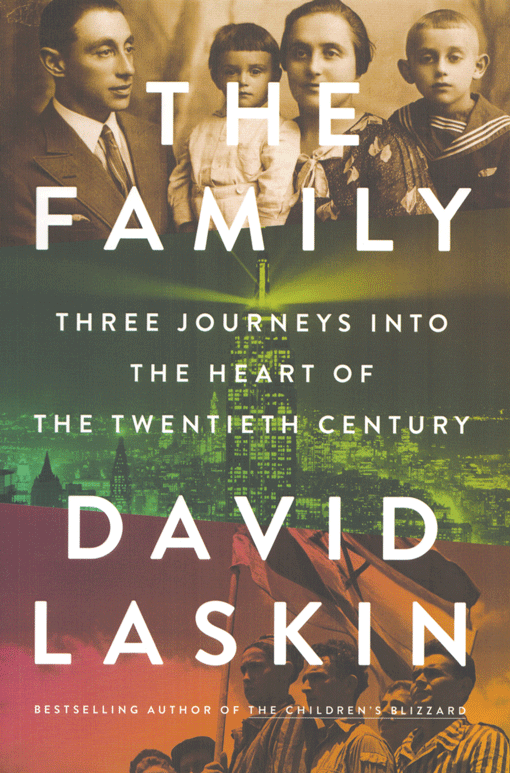The Family: Three Journeys into the Heart of the Twentieth Century, by David Laskin, Viking, 383 pages, $32
Reviewed by NEAL GENDLER
Yet another book about an extended Jewish family? My first reaction was “Why should I care,” but David Laskin’s smooth, well-researched account is compelling reading – and not only because his great aunt ruled the mighty empire of Maidenform.
In fact, the story of Itel and Wolf Rosenthal, by 1950 brassiere-makers to one of every 10 American women, isn’t the most interesting in The Family, which follows descendants of pious scribe Shimon Dov Hakohen.
“The three branches of my mother’s family endured and enacted the great Jewish upheavals of the 20th Century — mass immigration to the United States, the founding of Israel, and the Shoah,” says Laskin, Seattle-based journalist and author of The Children’s Blizzard. “One family — three fates.”

Laskin cleverly, if flippantly, calls his great-great-grandfather Hakohen “one of God’s secretaries,” who “laid down the law stroke by black stroke on the scraped, sanded hides of animals,” in Volozhin, now in Belarus.
Hakohen’s son Avram Akiva Kaganovich, also a scribe, married and moved to nearby Rakov, where their first surviving child, Itel, defied family piousness, dominated her family and became a burning socialist. Avram’s brother Shalom Tvi followed, marrying into a prosperous leather business. In 1901, their brother Yasef immigrated to America, becoming Joseph Cohn of Hoboken, N.J. Other relatives followed, and in 1909, so did Avram and wife, joining Ida and three of her siblings.
Eventually, Avram became Abraham Cohen and part of his sons’ wholesale business. Socialists Itel and Wolf became Ida and William, rejected religion and didn’t circumcise their son. Ida became a successful dressmaker, then an undergarment capitalist; Laskin calls her “a genius at branding” who was “born to be a tycoon.”
By 1932, Shalom Tvi’s granddaughter Sonia left Rakov to follow her cousin Chaim’s Zionist zeal. Married in 1933, they began a life of toil in seaside moshav Kfar Vitkin. Through them, we learn of the privation of Israel’s pioneers.
In 1938, Sonia made an extended visit to her sisters in Poland, where she was stunned by the level and burdens of anti-Semitism. “Everybody had said Sonia was crazy for leaving Rakov for Palestine, but with Poland the way it was now, she looked like the sane one and they should have their heads examined,” Laskin says.
Eighteen family members remained in Europe, and the book’s most moving portions are their letters, with pleas to be brought to America, and those showing the despair of the sole survivor, Shalom Tvi, who came to visit Abraham in summer 1939 and couldn’t return. Our foreknowledge makes the letters heartbreaking. Laskin cannot say for certain when and how his family died, but his clever sarcasm about German greed bears highlighting: “The Jews were filthy vermin, but evidently their goods escaped the taint.”
Shalom Tvi left New York to join Sonia in 1946. The Israeli family has grown to 32 and the Americans to 101. The book mercifully includes a two-page family tree, plus notes, a glossary and an index.
Laskin became Bar Mitzva in what he calls his “reformed” congregation, but I was a bit put off by his assertions of subsequent secularity. His introduction says: “Though I have ceased to attend synagogue and don’t claim my ancestors’ knowledge or share their faith, I have come to love and revere the Judaism that sustained my family through the generations.” His writing shows the reverence, but apparently it’s only for the past.
“I don’t pray. I don’t observe the cycle of the Jewish year. I rarely read the Bible,” he says in his epilogue. Well, he’s free to do – or not do — as he wishes, but why does he feel a need to tell us? And what would God’s secretary say?
***
Neal Gendler is a Minneapolis writer and editor
(American Jewish World 11.8.13)




















I’m presently reading Laskin’s book and am captivated. At times, I hear music from “Fiddler on the Roof”; at others , an ominous vision of the massacre in the market square in Zhivago.
The book is an eye-opener for one who is only now discovering the history of her own family. Certain things explain my ancestry and likely make me less impatient with the lack of disclosure on the part of my relatives. What now intrigues me was better left unsaid to them.
I have noticed the need for the author to explain his lack of any interest in the faith of his fathers. But I’ve seen that in the comments from many of my cousins , both those raised within the Christian faith and those raised as Jews. Most see nothing beyond a cultural significance; many are either indifferent or hostile to any “religious” commitment on the part of the few who seek communion with God. It seems to permeate much of the society today and David Laskin, like many of his peers, sees no reason to embrace anything beyond the tangible.
Still I enjoy the story. My hope, my prayers for all those in my family and Mr. Laskin’s and the many of our people who have forgotten the promise that a revival of seeking God’s face will take place.